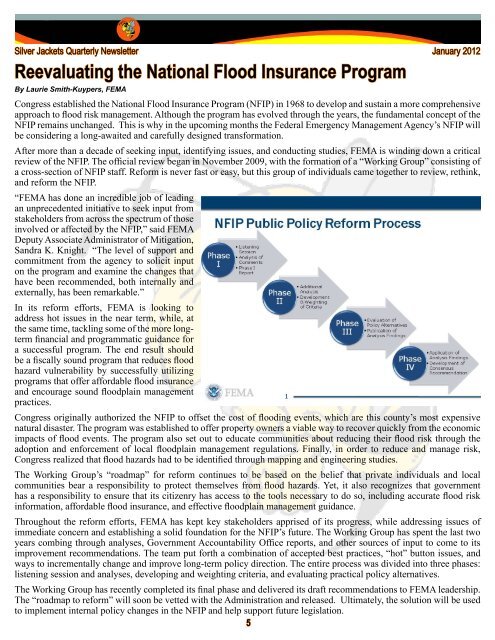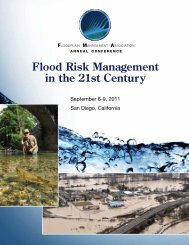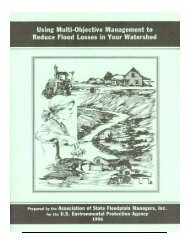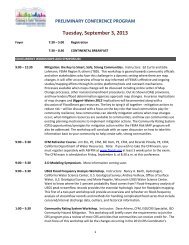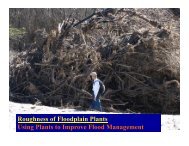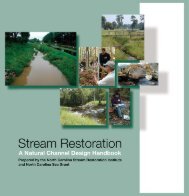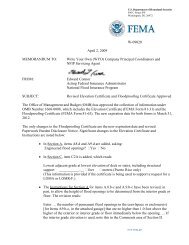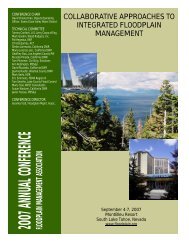Silver Jackets Quarterly Newsletter, January 2012 - Floodplain ...
Silver Jackets Quarterly Newsletter, January 2012 - Floodplain ...
Silver Jackets Quarterly Newsletter, January 2012 - Floodplain ...
You also want an ePaper? Increase the reach of your titles
YUMPU automatically turns print PDFs into web optimized ePapers that Google loves.
<strong>Silver</strong> <strong>Jackets</strong> <strong>Quarterly</strong> <strong>Newsletter</strong><br />
Reevaluating the National Flood Insurance Program<br />
By Laurie Smith-Kuypers, FEMA<br />
<strong>January</strong> <strong>2012</strong><br />
Congress established the National Flood Insurance Program (NFIP) in 1968 to develop and sustain a more comprehensive<br />
approach to flood risk management. Although the program has evolved through the years, the fundamental concept of the<br />
NFIP remains unchanged. This is why in the upcoming months the Federal Emergency Management Agency’s NFIP will<br />
be considering a long-awaited and carefully designed transformation.<br />
After more than a decade of seeking input, identifying issues, and conducting studies, FEMA is winding down a critical<br />
review of the NFIP. The official review began in November 2009, with the formation of a “Working Group” consisting of<br />
a cross-section of NFIP staff. Reform is never fast or easy, but this group of individuals came together to review, rethink,<br />
and reform the NFIP.<br />
“FEMA has done an incredible job of leading<br />
an unprecedented initiative to seek input from<br />
stakeholders from across the spectrum of those<br />
involved or affected by the NFIP,” said FEMA<br />
Deputy Associate Administrator of Mitigation,<br />
Sandra K. Knight. “The level of support and<br />
commitment from the agency to solicit input<br />
on the program and examine the changes that<br />
have been recommended, both internally and<br />
externally, has been remarkable.”<br />
In its reform efforts, FEMA is looking to<br />
address hot issues in the near term, while, at<br />
the same time, tackling some of the more longterm<br />
financial and programmatic guidance for<br />
a successful program. The end result should<br />
be a fiscally sound program that reduces flood<br />
hazard vulnerability by successfully utilizing<br />
programs that offer affordable flood insurance<br />
and encourage sound floodplain management<br />
practices.<br />
Congress originally authorized the NFIP to offset the cost of flooding events, which are this county’s most expensive<br />
natural disaster. The program was established to offer property owners a viable way to recover quickly from the economic<br />
impacts of flood events. The program also set out to educate communities about reducing their flood risk through the<br />
adoption and enforcement of local floodplain management regulations. Finally, in order to reduce and manage risk,<br />
Congress realized that flood hazards had to be identified through mapping and engineering studies.<br />
The Working Group’s “roadmap” for reform continues to be based on the belief that private individuals and local<br />
communities bear a responsibility to protect themselves from flood hazards. Yet, it also recognizes that government<br />
has a responsibility to ensure that its citizenry has access to the tools necessary to do so, including accurate flood risk<br />
information, affordable flood insurance, and effective floodplain management guidance.<br />
Throughout the reform efforts, FEMA has kept key stakeholders apprised of its progress, while addressing issues of<br />
immediate concern and establishing a solid foundation for the NFIP’s future. The Working Group has spent the last two<br />
years combing through analyses, Government Accountability Office reports, and other sources of input to come to its<br />
improvement recommendations. The team put forth a combination of accepted best practices, “hot” button issues, and<br />
ways to incrementally change and improve long-term policy direction. The entire process was divided into three phases:<br />
listening session and analyses, developing and weighting criteria, and evaluating practical policy alternatives.<br />
The Working Group has recently completed its final phase and delivered its draft recommendations to FEMA leadership.<br />
The “roadmap to reform” will soon be vetted with the Administration and released. Ultimately, the solution will be used<br />
to implement internal policy changes in the NFIP and help support future legislation.<br />
5


